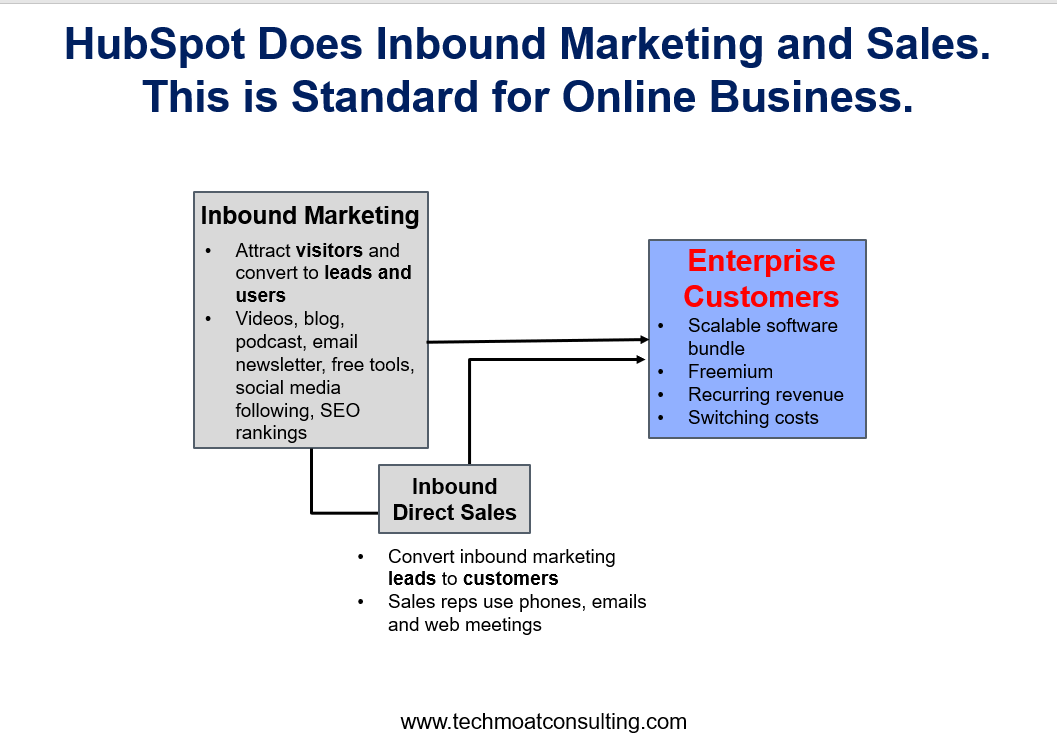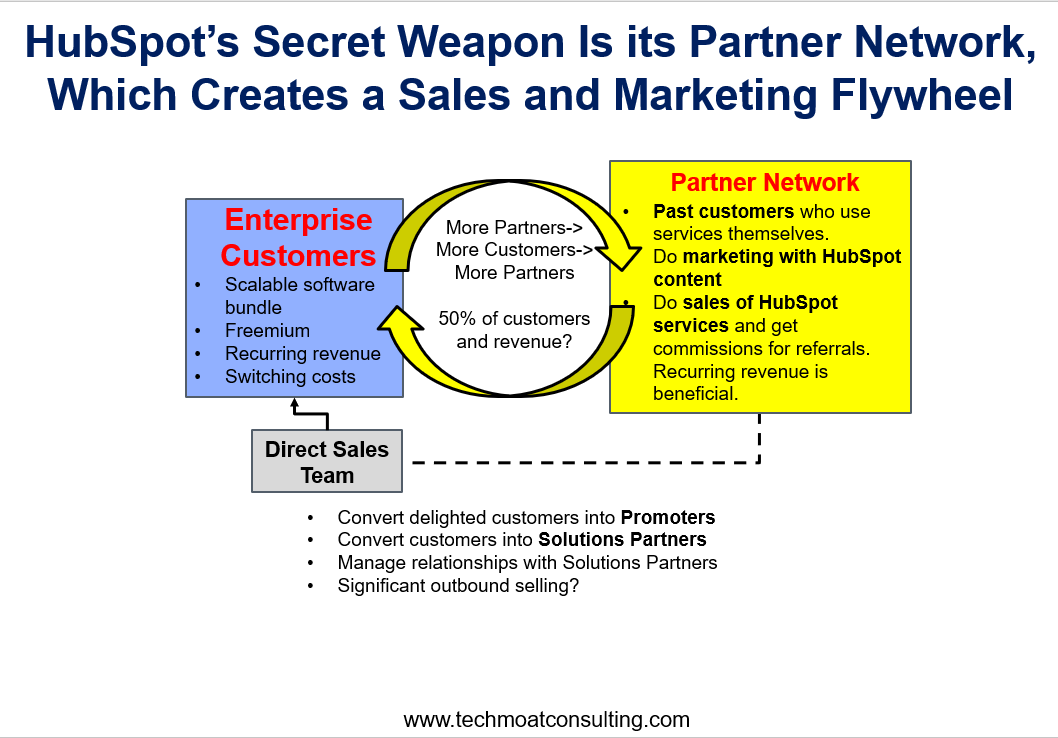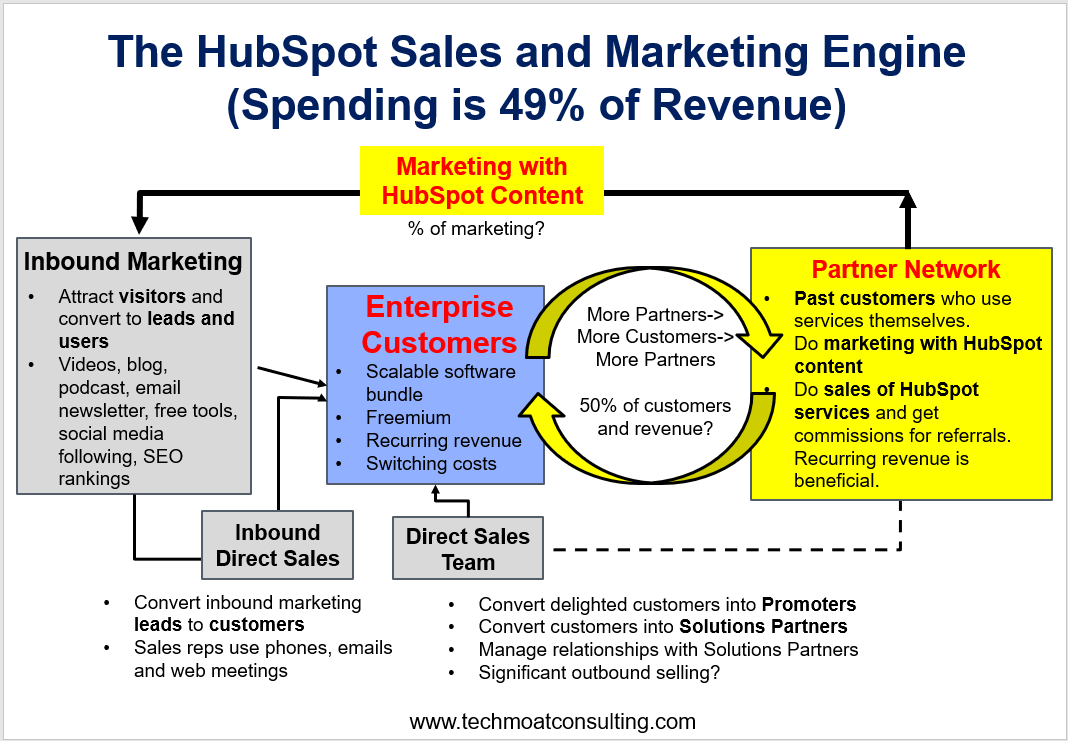- HubSpot is able to market and sell its enterprise software to SMEs globally. That is usually particularly difficult.
- They use both inbound marketing and a “Sales and Marketing” Flywheel to do this.
- Their Solutions Partner network is their secret weapon for this.
***
In Part 1, I broke down the HubSpot business model in theory and practice. Which are different. But both are great.
In this article, I just want to talk about how they do sales and marketing. Because this is really their key operational activity.
Yes, they do lots of R&D and software development. But these digital services are relatively easy to replicate. And software doesn’t cost that much (compared to say factories). The barrier to entry for offering these types of digital goods is not that high.
But HubSpot does have lock in / switching costs with customers. That’s what makes enterprise software more profitable than most types of digital goods.
So, the key activity is sales. You have to get your products and sold and integrated into you clients as fast as possible. That’s the high ground. HubSpot is ultimately a sales centric operation.
And you can see this how much HubSpot spends on sales and marketing. In 2023, it was 49% of revenue. That’s huge.
And we can break this into two parts. The sales and marketing they do internally. And the part done by partners.
HubSpot Does Standard Inbound Marketing and Sales. That’s Fine. But Table Stakes in Online Business.
As a thought leader and service provider in inbound marketing, it’s not surprising that HubSpot does this activity well itself. Here’s a simple illustration.

These graphics are mine, but the text is from their filings. They do:
- Inbound marketing that attracts visitors and converts them to leads. This is a lot of content creation, email marketing, SEO and so on.
- Inbound direct sales converts these leads to customers. That means sales reps using phones, email, and web meetings. This is all done online. Not in person like Salesforce.
And that’s a good model. The graphic above is a pretty good description of most online businesses. Although most don’t feed into the attractive combination of bundles, freemium, and switching costs.
However, HubSpot also has a partner network. And this is the part that is really worth studying.
HubSpot’s Big Weapon Is Its Solution Partner Network and Flywheel
From day one, HubSpot had a difficult problem. It was trying to sell enterprise software to small and medium businesses. And this is one of areas that a lot of entrepreneurs avoid. The sales process is difficult. Then there is onboarding and installation. Then there are customer service and support requirements. Plus, they often want customization. Most enterprise software is a combination of software, direct sales, customer service and consulting.
It’s just too hard.
Salesforce and Microsoft don’t have this problem. They built their businesses on large corporations and multinationals. And they have built out huge sales departments with tens of thousands of people. Plus, they have consulting services. And big support functions.
HubSpot’s approach has been to build a Solutions Partner network. These are agencies and service businesses all over the world. You can go on the HubSpot website and find a solutions partner in just about any country and any city. You can specify the language they speak. You can choose between being available locally versus online. And you can specify expertise.
These are the firms that specialize in CRM marketing, sales, and implementation. They do website development, consulting, and lots of other services. They make their money selling their own services. But they also can get a commission for referrals to HubSpot. So, they can get part of that recurring revenue. And that stable recurring income can be very helpful for small boutique agencies. They make their money by service fees, commissions and training and consulting fees.
You can find them in the HubSpot Partners Directly. They are verified by HubSpot in areas such as HubSpot Onboarding, Advanced CRM Implementation, HubSpot Custom Integration, Data Migration, Platform Enablement. They can get accreditation in specific areas. And they have customer reviews.
That looks like this:

The Solutions Partners do marketing and sales of HubSpot services. And this creates a flywheel. More partners means more HubSpot customers. Which means more partners sign up to sell the widely used product.
In its 10k, HubSpot says 31% of customers and 46% of revenue is from their partner network. And they cite the continued participation of solutions partners as one of their main risks.
HubSpot also has a Direct Sales Team. They manage relationships with the solutions partners. And I believe they do outbound selling. But I’m not sure how much.
Put all this together and you get this graphic. Which is awesome.

Note how the partner network amplifies both sales and marketing. It’s a great approach for selling to small and medium businesses.
Conclusions
- HubSpot has good inbound sales and marketing. It does this without mostly online, without large operating staff.
- Its biggest weapon is its Solutions Partner network. This creates a “Sales and Marketing” Flywheel that enables it grow organically. Even across borders.
***
That’s it for today. In Part 3, I’ll go through the keys for HubSpot going forward. Why I think is great but also what worries me.
Cheers, Jeff
- Why the Future of HubStop Worries Me (3 of 3) (Tech Strategy)
- I Love the HubStop Business Model. But Not the One They Describe. (1 of 3) (Tech Strategy)
———
Related articles:
- A Digital Strategy Breakdown of Salesforce. Spoiler: It’s Awesome (1 of 3) (Tech Strategy – Daily Article)
- Is GenAI Disrupting Salesforce? The Rise of Intelligent CRM? (Tech Strategy – Podcast 215)
- A Strategy Breakdown of Arm Holdings (1 of 3) (Tech Strategy – Daily Article)
From the Concept Library, concepts for this article are:
- SaaS
- Enterprise Software: CRM
- Operational Flywheels: Sales and Marketing
From the Company Library, companies for this article are:
- HubSpot
Photo by GenAI
——-–
I am a consultant and keynote speaker on how to accelerate growth with improving customer experiences (CX) and digital moats.
I am a partner at TechMoat Consulting, a consulting firm specialized in how to increase growth with improved customer experiences (CX), personalization and other types of customer value. Get in touch here.
I am also author of the Moats and Marathons book series, a framework for building and measuring competitive advantages in digital businesses.
This content (articles, podcasts, website info) is not investment, legal or tax advice. The information and opinions from me and any guests may be incorrect. The numbers and information may be wrong. The views expressed may no longer be relevant or accurate. This is not investment advice. Investing is risky. Do your own research.
